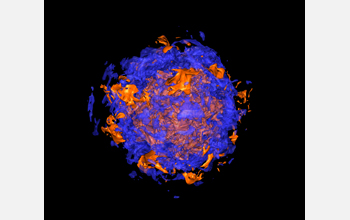Multimedia Gallery
3-D Simulations of Exploding Supernovae (Image 1)
A Princeton University-led team of researchers found a way to make computer simulations in 3-D of supernovae exploding, which may lead to new scientific insights. Even though these mammoth explosions have been observed for thousands of years, for the past 50 years, researchers have struggled to mimic the step by step destructive action on computers. The 3-D simulations like this one are based on the idea that the collapsing star itself is not sphere-like, but distinctly asymmetrical and affected by a host of instabilities in the volatile mix surrounding its core.
This research was funded in part by a grant from the National Science Foundation (PHY 08-22648). To learn more, see the Princeton news story 3-D computer simulations help envision supernovae explosions. (Date of Image: Summer 2010) [Image 1 of 6 related images. See Image 2.]
Credit: Adam Burrows and Jason Nordhaus, Department of Astronomical Sciences, Princeton University
Images and other media in the National Science Foundation Multimedia Gallery are available for use in print and electronic material by NSF employees, members of the media, university staff, teachers and the general public. All media in the gallery are intended for personal, educational and nonprofit/non-commercial use only.
Images credited to the National Science Foundation, a federal agency, are in the public domain. The images were created by employees of the United States Government as part of their official duties or prepared by contractors as "works for hire" for NSF. You may freely use NSF-credited images and, at your discretion, credit NSF with a "Courtesy: National Science Foundation" notation.
Additional information about general usage can be found in Conditions.
Also Available:
Download the high-resolution TIF version of the image. (10.6 MB)
Use your mouse to right-click (Mac users may need to Ctrl-click) the link above and choose the option that will save the file or target to your computer.



